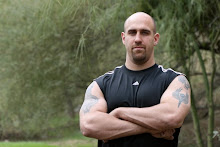Wow! Did I get some emails about my last post! It seems as though I really struck a nerve with a lot of people that have strong feelings about the pros and cons of Strongman training. First, we have to clearly define Strongman training, I am speaking specifically of the events in Strongman Contests. This would include:
Log/Axle clean and jerk
Farmer's Walks
Yoke Walks
Tire Flips
Stone Lifting
Car Pulling
Sure, I am missing a few, but these are the most common ones. Strongman training is not sledgehammers, bent pressing, kettlebells, get-ups, etc. This falls into general training as this is not training used in competitive strongman events.
So, what is my problem? It isn't with any of the events or lifts, it is purely with how they are employed and who they are used with. It has become commonplace to quote some of the greats of old time strength training; Saxon, Hackenschmidt, Jowett, and many others. These men were immensely strong and athletic, but there is many things that are often not mentioned about their training.
1. Most of the old time lifters came from a background of manual labor, often farming or other industrial jobs. This meant years of intense physical training building their fitness and supporting system of ligaments and tendons.
2. The old time lifters were often very proficient and even competitive in wrestling and gymnastics. This gave them strength in a wide array of body positions and angles. It provided them proper conditioning to handle high intensity loads, and possessed amazing dynamic flexibility.
3. All these men would discuss the important role of spending time performing general exercises for an extensive period of time before pursuing more intense training.
4. This was a time before highly processed foods that often impedes and impacts recovery.
All things considered, these men did not really perform the strongman lifts of today and to make comparisons is highly inaccurate.
We only hear the benefits of doing Strongman training, so what are some of the drawbacks?
1. Heavy walking exercises can often place a great deal of compressive forces on the spine and/or hips. Because it is very hard to stabilize the pelvis under these conditions one's hip girdle gets negatively impacted. Don't believe me? Test your hamstring and hip flexor strength and flexibility after doing heavy farmer's walks and/yokes! Impeding hamstrings and hip flexors is devastating to an athlete and can destroy performance. For general population it can cause back pain and discomfort in the long run.
2. Farmer's walks especially torch the upper traps. For many people, they possess an unusually high level of activity and stress in the upper traps. When they perform these lifts they can develop severe neck restrictions and pains. This is a place for referral pains as well and can cause shoulder and upper arm type of pain symptoms.
3. Stones and tire flipping place the body in an imperfect lifting posture. Again, if the lifter is not proficient at bracing and understanding how to stabilize their pelvis the back can potentially get injured. A great deal of time needs to be spent teaching pelvic stabilization and core strength in many positions including extended.
4. Thick bar work and heavy duty gripping can cause some major problems in the elbows. Because these muscles can get easily overworked, tennis elbow type of symptoms.
Many people tend to forget that Strongman training is training for a sport in of itself. As with many sports, there are aspects that are not healthy, but necessary for performance. Especially at the higher levels of sport one increases their risk of compounding the negative aspects. That isn't to say that you couldn't use these lifts, in Part III I will discuss how to wisely implement such exercises.
Monday, May 18, 2009
The Misuse of Strongman Training Part II
Subscribe to:
Post Comments (Atom)





No comments:
Post a Comment